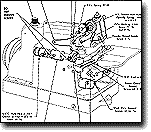
70 Class Machines Setup & Operation
| SEWING | CUTTING | FEEDING |
| Needles | General information | Feed dogs |
| Loopers | Knife adjustment | Presser foot |
| Threaading diagrams | Sharpening the cutters | Framecap assembly/Cams |
OUT OF THE BOX
 |
1) Upon removing the machine from its box observe its threading carefully and compare it with the threading diagram supplied with the machine.
Keep this threading diagram for future reference. The matter of threading is very important and if difficulty arises, the threading of the machine should be compared with the individual diagram supplied. Threading is simple, but it must be accurate.
2) Secure the machine mounting assembly to the table with the three screws provided. This assembly should be:
| A. |
Parallel with the center line of the motor. |
| B. |
When the machine is set on the assembly, the front of the machine will be three or four inches back from the front of the table with its Hand Wheel to the right of the operator. |
| C. |
The Hand Wheel Belt Groove should line up with the Motor Pulley Groove, when the Motor Pulley is in the running position. |
 |
3) Check the Hand Wheel (belt) Guard to be sure it does not hit the belt. Adjust if necessary; by removing screw, repositioning, and replacing screw.
4) Assemble Thread Stand and screw its base to the table at the rear of the machine.
5) The thread guides at the top of the Thread Stand should be directly over the center of the cones of thread.
6) The thread or yarn should be wound on cones, which should stand vertically. The thread from these cones should lead up to the Safety Cross Rod (8-52-J) through the thread eyes and diagonally downward to the machine. Note: The Safety Cross Rod should be installed with the thread eyes below the rod. Care should be taken to be sure the threads are far enough apart so that they will not whip together when the machine is running at speed.
7) Be sure the thread will come off the cones readily, with uniform tension and that it cannot catch under the cone or elsewhere along its path.
8) Since the oil has been drained from the machine before shipping, the main reservoir must be filled before the machine is used (Note section 15).
SPEED
9) The Styles
70-D3B-2 and 70-Y3B-2 have a recommended speed of 2250 stitches
per minute. Styles 70-D3B and 70-Y3B are designed to run at 1500-1800
stitches per minute. Merrow Styles 70-ABB, 70-AND-1 and 70-ABBY
are designed to run at 2800-3000 stitches per minute. Merrow Style
70-1D-2 is designed to run 4000 stitches per minute. While these
machines may run well with little care, they will give better results
with suitable attention.
MOTOR
10) To obtain
full efficiency, the Motor Drive equipment must be kept in good
operating condition in order to start and stop the machine with
minimum delay. When laying out the Motor Drive equipment, attempt
should be made to avoid driving from a large pulley to a relatively
smaller pulley, the centers of which are close together, as such
an arrangement will allow excessive slippage of the belts, materially
reducing the speed of the start and stop of the Merrow Machine.
11) A V-Belt Hand Wheel with an effective (pitch) diameter of 3-1/3" (85mm) is supplied with 70-D3B and Y3B Models. On 70-ABB and ABBY machines the effective (pitch) diameter is 2-1/8" (54mm). If an individual motor is being used, the machine may be run with a 3/8" (9.5mm) width endless V-Belt. Where round belting is used, either 1/4" (6.5mm) or 5/16" (8mm) round belting may be used.
12) The top of the Hand Wheel of all Class 70 machines must turn away from the operator.
13) Consult your nearest Merrow Distributor to assure proper motor drive equipment.
|
|